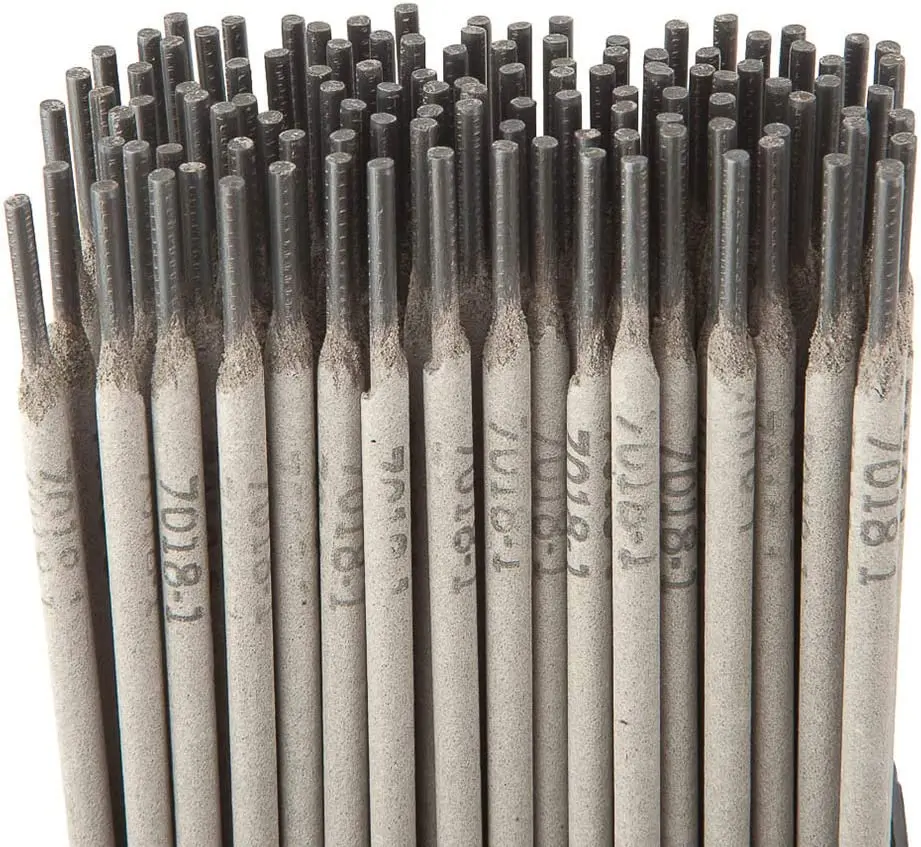7018 welding rods offer better tensile strength and lower hydrogen content, ideal for sturdy, clean welds in structured projects. 6011 welding rods offer deeper penetration and versatility with polarity and positions, which is ideal for rough conditions and repairs.
Table of Contents
What is 7018 Welding Rod Used For?
My experience with 7018 welding rods, or electrodes as some may call them, has mostly been in structured environments. The low hydrogen coating of e7018 electrodes makes them great for producing clean and crack-resistant welds. This feature, combined with their 70,000 PSI tensile strength, makes them the go-to welding rod for projects that require high strength and durability.
I often use 7018 rods for welding critical structures like bridges, skyscrapers, and pipelines. They offer smooth weld beads and easy slag removal, and most importantly, I can trust them to handle immense stress over time.

When Not to Use 7018 Welding Rod
Despite the robustness and versatility of 7018 welding rods, there are times when they aren’t my first choice. The key limitation is maintaining the coating in a dry condition. Due to the low hydrogen content, any moisture can lead to under-bead or weld cracking.
Additionally, while the 7018 rod provides moderate penetration, it may not suffice for certain tasks. I’ve encountered situations, especially when dealing with dirty or rusty steel, where the 7018 didn’t deliver the required penetration level, leading me to seek alternatives.
What is a 6011 Welding Rod Used For?
In contrast to the 7018, my use of 6011 welding rods is typically when I’m faced with less-than-perfect welding conditions. If I’m dealing with rusty, dirty, or painted metals, 6011 is my trusty companion. The high cellulose sodium coating enables these rods to penetrate deep, allowing for a good weld even under rough conditions.
The versatility of 6011 welding rods is a significant advantage. They can work with any polarity – AC, DCEN, or DCEP, which means they adapt well to different power sources.

When Not to Use 6011 Welding Rod
Despite their impressive versatility, 6011 welding rods have limitations. The tensile strength of these rods is somewhat lower (60,000 PSI compared to the 70,000 PSI of 7018). This makes them less suitable for welding high-strength structures where maximum strength and crack resistance are crucial.
Also, the welds created with 6011 may not be as aesthetically pleasing as those with 7018. Producing smooth welds and proper slag removal requires more skill and precision.
Different Properties between 7018 and 6011 Welding Rods
Let’s examine the key differences between these welding rods – tensile strength, polarity, and penetration depth.
Tensile Strength
Tensile strength, the capacity of a material to resist breaking under tension, is a vital attribute in welding rods. Here’s where the 7018 welding rods stand out. With an impressive tensile strength of 70,000 PSI, they confidently outperform the 6011 rods, which offer a respectable 60,000 PSI. This considerable gap in tensile strength gives the 7018 rods a clear advantage when welding high-strength structures.
From bridges to pipelines to building structures, when I need a weld that will withstand substantial stress, I reach for my 7018 rods. They provide that extra reassurance in maintaining the integrity of the weld over time.
While the 6011 rods may lag in this department, their tensile strength is still more than sufficient for general repair work or when dealing with less critical structures.
Polarity
Welding isn’t always about strength. Versatility is another key factor when choosing between 7018 and 6011 rods. This is where 6011 welding rods steal the limelight. They are compatible with all types of current: AC (Alternating Current), DCEN (Direct Current Electrode Negative), and DCEP (Direct Current Electrode Positive).
This characteristic makes 6011 rods a veritable jack-of-all-trades, allowing them to adapt to any welding situation. Whether working with a rudimentary stick welder in a garage setup or a high-end welding machine in a professional welding shop, the 6011 rods are ready to play.
7018 rods are somewhat more limited, compatible only with AC and DCEP. This restriction doesn’t affect their performance in environments where these power sources are available, but it does make them less flexible for varying work conditions.
Penetration
Regarding penetrating power, the 6011 rods have a distinct edge. They offer deep penetration, making them the perfect ally for welding through rust, dirt, or paint. In my experience, when I’m dealing with less-than-ideal materials, the 6011 rods come to the rescue, cutting through impurities to create a solid weld.
The 7018 rods, while excellent in many respects, offer only moderate penetration. This level is more than sufficient when dealing with clean materials and conditions. However, when faced with more challenging surfaces like rusty or painted metals, they may struggle to deliver the same level of weld penetration.
Understanding these limitations helps me select the right rod for the job as a welder, ensuring the best possible weld every time.
Conclusion
Deciding between 7018 vs 6011 welding rods depends on the project at hand. For high-strength, clean, and critical structures, I lean towards the 7018 rods. But when faced with challenging conditions, where deep penetration and versatility are needed, I turn to the 6011 rods.


